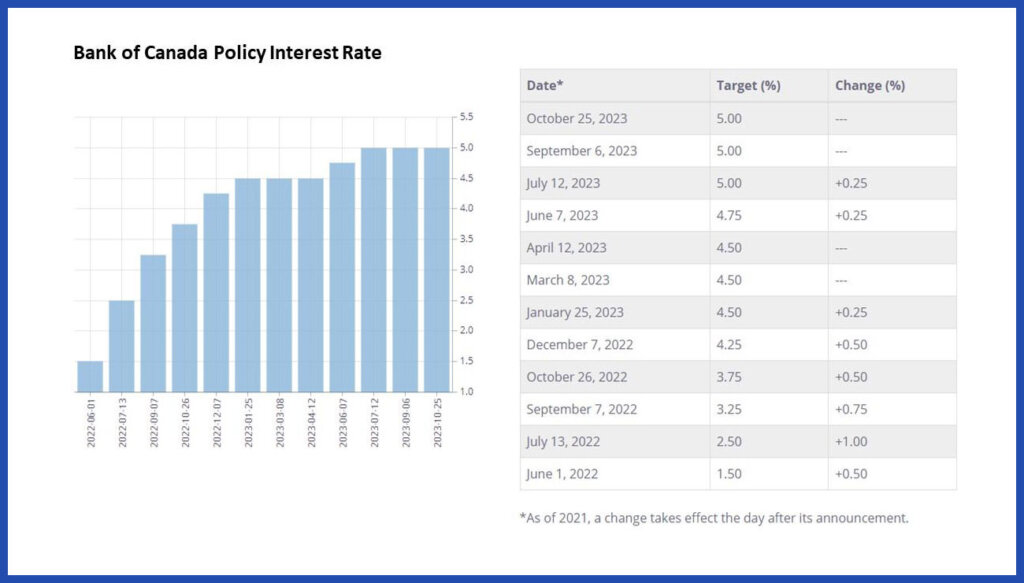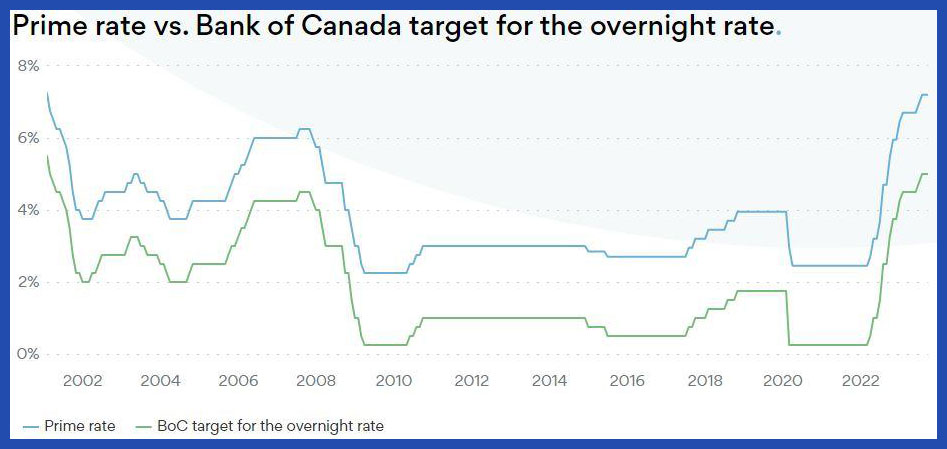Making sense of the markets this week: October 29, 2023
Big Tech third-quarter earnings are in, Bank of Canada pauses interest rate hikes, U.S. 10-Year Treasury Bond yields briefly top 5%, and all eyes on mortgage rates.
Advertisement
Big Tech third-quarter earnings are in, Bank of Canada pauses interest rate hikes, U.S. 10-Year Treasury Bond yields briefly top 5%, and all eyes on mortgage rates.

Allan Small, Senior Investment Advisor at the Allan Small Financial Group with iA Private Wealth, shares financial headlines and offers context for Canadian investors.
Earnings season is here, as technology’s biggest players reported their third quarter earnings. This follows on the heels of the big U.S. banks reporting their earnings the week prior. The main takeaway from the banks’ earnings—which were pretty good across the board—and what their CEOs said, that the money in consumers’ savings accounts is dwindling. And that points to less spending and a slowing economy in the near future. (All values in this section are in U.S. currency.)
This week, we heard from the tech titans, including Microsoft, Alphabet and IBM. What do you, Canadian investors, want to know specifically about tech stocks? Is growth still happening, and from where is it coming from? The third quarter earnings reports demonstrate just why tech has been the only real centre for growth in the markets over the past year—and why that growth will continue. Their success is pinned largely to investments in artificial intelligence (specifically generative AI and ChatGPT), which is already revolutionizing how we live and the way businesses function (aside from when AI’s not making things better). Qualcomm just announced two new computer chips that will bring AI to our smartphones and laptops. And that means another upgrade cycle for smartphone and laptop manufacturers.
Here are the tech earnings released this week.
Microsoft is a particular standout. Trading at 30 times earnings, it beat Wall Street expectations, with revenues rising 13% to $56.5 billion in the quarter. Its Intelligent Cloud, home to its Azure cloud computing platform where most of the AI development is taking place, grew to $24.3 billion—an increase of 29%.
Alphabet—Google and YouTube’s parent company—hit $77 billion in revenue, up 11% year over year. That was largely driven by growth in search and YouTube. The double-digit revenue growth follows “four quarters” of single-digit growth. However, its Cloud numbers missed analysts’ estimates for the quarter, which caused markets to overreact and its stock price to dip, creating what some investors may view as a buying opportunity.
Meta also had a strong showing, thanks to a recovery in digital ad sales, which pushed revenue up by 23% year over year to $34.15 billion—its fastest growth rate since 2021.
Two other big numbers from Meta:
When you consider there are about 8 billion people on the planet, this is amazing. That means more than a quarter of the world’s population logs onto Facebook and/or Instagram every day. This is the place to be for advertisers.
Legacy tech company IBM also had a strong quarter and beat analysts’ expectations. Revenue hit $14.75 billion, up 4.6% year over year in the quarter. Net income hit $1.7 billion or $1.84 a share versus a net loss of $3.20 billion a year ago. (Largely the result of a $5.9 billion pension settlement chart).
IBM’s business is split into two key divisions: IT consulting and software. The latter is the primary revenue driver. The software unit generated $6.27 billion revenue, up 8% versus the consulting division, generating $4.96 billion in revenue, up 6%. Like many tech companies, IBM’s software division is also investing in AI to drive future growth.
Amazon announced record third-quarter profits after the close Thursday and surged 5% Friday morning (at press time) after strong growth in its highly profitable Cloud business. While the stock was up 40% on the year, shares had fallen 8% in the previous two days after rival Alphabet warned that cloud customers were curbing spending.
While North American bank stocks answered the question about how the economy is fairing, technology stocks answered questions about growth. The big message with tech is that growth is still there, and it will continue to be going forward. In today’s market, investors looking for growth need to own at least a few big-cap tech stocks. These companies are becoming the consumer staples of tomorrow. That includes stocks from companies like food and grocers and utilities that ground portfolios. That’s because, when the market dips, people still have to buy food and heat their homes. In today’s digital age, the technologies we’ve been talking about are embedded in our everyday lives and are poised to continue to grow.
The general consensus going into the week was that Bank of Canada Governor Tiff Macklem would push the pause button on another interest rate hike. And that’s exactly what he did on Wednesday. Even though interest rates didn’t go up another quarter point—which was the plan—the damage has been done. Some Canadian investors and the markets worry that another rise in interest rates could increase the pressure on individual households and businesses, ratcheting up the fear and likelihood of a recession.

The Bank of Canada (BoC) itself was under a lot of pressure from provincial premiers to hold off on a rate hike precisely for these reasons. That’s despite not being closer to the 2% inflation target the BoC has set its sights on. For me, though, the question has always been: Is 2% a realistic target? And even if it is, how much pain is the BoC willing to inflict on the economy to achieve it?
Personally, I’d rather see a 3% inflation rate target, along with strong employment and healthy consumer spending, over targeting 2% inflation and lost jobs and a recession. Some analysts are predicting that the recession that was expected this year will take hold next year.
Ahead of this week’s decision on interest rates, I’ve written to the Governor of the Bank of Canada to again express my opposition to any further rate hikes. Higher interest rates are hurting people and businesses that are already struggling to pay their bills. pic.twitter.com/B0l4yBYDAO
— Doug Ford (@fordnation) October 22, 2023
I’m surprised we’re here, in the third week of October, still talking about interest rate hikes. I thought by now the central banks would have stopped relying on them so heavily. The Bank of Canada has raised interest rates 10 times since March 2022.
It’s interesting that both the BoC and the U.S. Federal Reserve keep referencing the lag effect between when a rate hike is implemented and when its effects show up in economic data. Yet, neither specify just how long this can and/or should take. How do we know if the hikes are working? Are they willing to blow everything up because we’re stuck on 2% inflation?
When you have the cost of borrowing tripled, in some cases because of all these interest rate hikes, I have to wonder whether the BoC is sending an inadvertent message to Canadians: “You are living beyond your means. You’ve enjoyed a run of many years of low interest rates, where money was basically free with no worry about what happens later, when the cost to carry debt rises. The days of high interest are here now for the foreseeable future.”
For another take on the involvement of government with the BoC’s duties, read columnist Kyle Prevost’s take.
On Monday, the benchmark 10-Year U.S. Treasury bond yield rose above 5% for the first time since 2007. Why are long-term bond yields rising?
Even though the U.S. economy is strong, with an anticipated GDP growth rate above 4% –which is phenomenal – it also has more than USD$30 trillion worth of debt to pay off. The government/treasury needs to generate money and they do this by selling long-term bonds but to sell them, they have to make the price attractive. When they drop bond prices, yields rise—and that’s where we are. (Values in this section are in U.S. currency.)
LATEST: The 10-year US Treasury yield exceeds 5% for the first time since 2007, signaling more pain for bond investors https://t.co/JNOoDZmnlJ pic.twitter.com/AG4M6tLl57
— Bloomberg Markets (@markets) October 23, 2023
In some ways, rising interest rates and long-term bond yields are packing a one-two punch to the markets. When the U.S. Federal Reserve raises interest rates, it affects the cost of borrowing. That leaves U.S. consumers with less discretionary spending money, which slows the economy and makes investors worldwide anxious about owning equities. And that can lead many investors, including Canadians, to sell. This makes sense for parts of the market that are particularly sensitive to interest rates, such as real estate and consumer staples.
What I don’t understand is why people sell off tech stocks when interest rates and bond yields rise. These are the stocks—Google, Amazon, Meta, Microsoft, NVIDIA, for example—that can achieve significant growth to rival higher inflation and interest rates. Many of these companies are flush with cash and have no need to borrow money.
High-yield bonds have a similar impact on the markets because they create competition for equities—something that hasn’t happened in decades. Until now, Canadian investors looking to grow wealth had no alternative than to be invested in the stock market—a phenomenon known as TINA. That stands for “there is no alternative.” (For more on that, read my column: “Does TINA still apply for the stock market? Are GICs and bonds a new option for Canadian investors?”
Today, any stock paying a dividend without much growth is going to be in tough. If you can make 5% on a 10-year bond with no risk versus 3% on a dividend-paying stock that has risk, which one will you choose?
In the U.S., mortgage rates have hit 8%. In Canada, the average mortgage rate is 6.33%. The prime lending rate is now 7.2%, up from 2.7% in March 2022, and the highest it has been in years.

Homeowners with variable rate mortgages in Canada are taking it on the chin. Since 2021, those rates are up 70%. Analysts estimate that some $331 billion in mortgages come up for renewal in 2024 and $352 billion in 2025. If and when the BoC raises interest rates again, the prime rate will also increase and so too will mortgage rates. This has the potential to be a huge problem for anyone refinancing their mortgage, and it will have a real impact on the economy. Of course, higher debt costs will leave Canadians with less spending money, which will slow down the Canadian economy.
But there is another ripple effect.
Over the past 20 years and more, real estate in general has been a very lucrative investment for Canadians living in or near urban centres. If we start to see demand for housing fall because of higher interest and mortgage rates—and from what I’m hearing, at least anecdotally, this is already happening—there is going to be a real hit to Canadians’ wealth and personal net worth. Some people may have to sell their home or investment property for less than what they purchased, creating negative equity. It’s also going to be that much more expensive to borrow to buy a home.
Is the BoC’s focus on inflation and increasing inflation rates worth it?
I, for one, don’t think so.
Share this article Share on Facebook Share on Twitter Share on Linkedin Share on Reddit Share on Email
Monetary policy can’t be dismissed by a simple conclusion about interest rates. It really is complicated! I suspect analysts don’t even agree about what happened in the early 1980s — and they’ve had a lifetime to study that. My humble opinion is that the federal government gave away too much money in 2020, and that’s why we need higher interest rates now. To the extent that the government has stopped giving away too much money, we’ll see the situation calm down. Tweaking is risky because the system is so sensitive to tiny changes in the BoC’s rate, but if they’ve got it right, we can hope to have our stable prosperity back soon enough. (Weren’t the 2010s just wonderful?)